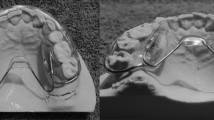Abstract
This study evaluated the efficacy of a treatment package which included tongue lateralization as part of chewing instruction. Participants consisted of three children who consumed only pureed food and had no history of chewing. Using the outcome measures, tongue lateralization and chewing, we demonstrated improvements in these outcomes for each of the three children. Prior to the end of treatment, all three transitioned to table food and continued to consume table food in follow-up. In addition to measuring changes in observed outcomes, three speech pathologists not involved with the intervention independently rated video clips taken across the course of treatment for each child. These independent raters reported improvements in both tongue lateralization and chewing. The current study was the first to demonstrate a method of integrating tongue lateralization into an intervention for chewing.



Similar content being viewed by others
References
Butterfield, W. H., & Parson, R. (1973). Modeling and shaping by parents to develop chewing behavior in their retarded child. Journal of Behavior Therapy and Experimental Psychiatry, 4(3), 285–287.
Collins, M. S., Kyle, R., Smith, S., Laverty, A., Roberts, S., & Eaton-Evans, J. (2003). Coping with the usual family diet: Eating behaviour and food choices of children with Down's syndrome, autistic spectrum disorders or cri du chat syndrome and comparison groups of siblings. Journal of Learning Disabilities, 7(2), 137–155.
Eckman, N., Williams, K. E., Riegel, K., & Paul, C. (2008). Teaching chewing: A structured approach. American Journal of Occupational Therapy, 62(5), 514–521.
Field, D., Garland, M., & Williams, K. (2003). Correlates of specific childhood feeding problems. Journal of Paediatrics and Child Health, 39(4), 299–304.
Gisel, E. G. (1994). Oral–motor skills following sensorimotor intervention in moderately eating-impaired child with cerebral palsy. Dysphagia, 9, 180–192.
Gisel, E. G., Schwaab, L., Lange-Stemmler, L., Niman, C. W., & Schwartz, J. L. (1986). Lateralization of tongue movements during eating in children 2 to 5 years old. American Journal of Occupational Therapy, 40(4), 265–270.
Le Révérend, B. J., Edelson, L. R., & Loret, C. (2014). Anatomical, functional, physiological and behavioural aspects of the development of mastication in early childhood. British Journal of Nutrition, 111(3), 403–414.
Ledford, J. R., & Gast, D. L. (2006). Feeding problems in children with autism spectrum disorders: A review. Focus on Autism and Other Developmental Disabilities, 21(3), 153–166.
Liberty, K. A., Haring, N. G., White, O. R., & Billingsley, F. (1988). A technology for the future: Decision rules for generalization. Education & Training in Mental Retardation.
Remijn, L., Speyer, R., Groen, B. E., van Limbeek, J., & Nijhuis-van der Sanden, M. W. (2014). Validity and reliability of the mastication observation and evaluation (MOE) instrument. Research in Developmental Disabilities, 35(7), 1551–1561.
Stolovitz, P., & Gisel, E. G. (1991). Circumoral movements in response to three different food textures in children 6 months to 2 years of age. Dysphagia, 6(1), 17–25.
Thommessen, M., Riis, G., Kase, B. F., Larsen, S., & Heiberg, A. (1991). Energy and nutrient intakes of disabled children: Do feeding problems make a difference? Journal of the American Dietetic Association, 91(12), 1522–1525.
Volkert, V. M., Peterson, K. M., Zeleny, J. R., & Piazza, C. C. (2014). A clinical protocol to increase chewing and assess mastication in children with feeding disorders. Behavior Modification, 38(5), 705–729.
Williams, K. E., Seiverling, L. J., & Field, D. G. (2014). Feeding problems. In Sturmey & Didden, Evidence-based practice and intellectual disabilities (198-218). New York: Wiley.
Author information
Authors and Affiliations
Corresponding author
Ethics declarations
Conflict of Interest
The authors declare no conflict of interest.
Ethical Approval
All procedures performed in studies involving human participants were in accordance with the ethical standards of the institutional and/or national research committee and with the 1964 Helsinki declaration and its later amendments or comparable ethical standards.
Informed Consent
Informed consent was obtained for each participant.
Additional information
Publisher’s Note
Springer Nature remains neutral with regard to jurisdictional claims in published maps and institutional affiliations.
Rights and permissions
About this article
Cite this article
Adams, W., Williams, K. & Ivy, J. Teaching Tongue Lateralization as a Component of Chewing Instruction. J Dev Phys Disabil 32, 1007–1022 (2020). https://doi.org/10.1007/s10882-020-09728-y
Published:
Issue Date:
DOI: https://doi.org/10.1007/s10882-020-09728-y




